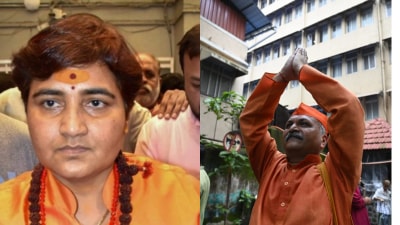Gujarat Hardlook | Ahmedabad’s traffic woes: A look at the challenges that choke the city
The year-on-year increase in the sales of two-wheelers in Gujarat was almost double the national average, with the state's share in that segment at over six per cent, as per the data released by the Federation of the Automobile Dealers Association (FADA) for January.
 The year-on-year increase in the sales of two-wheelers in Gujarat was almost double the national average, as per the data released by FADA for January. (Express File Photo)
The year-on-year increase in the sales of two-wheelers in Gujarat was almost double the national average, as per the data released by FADA for January. (Express File Photo) Located in the heart of Gujarat, Ahmedabad faces traffic woes due to more reasons than one. It handles not just local traffic but also national highways with vehicles bound for different parts of the country passing through the city.
With a rise in private vehicle ownership over the years – evident in vehicle registration and retail sale data – the chaos has only increased, say observers. RIJIT BANERJEE reports.
Lack of adherence to lane-driving, preference for private over public transport, and diminishing deterrence linked to fines among violators — these are some of the challenges that the Ahmedabad Traffic Police often faces, according to officials.
The year-on-year increase in the sales of two-wheelers in Gujarat was almost double the national average, with the state’s share in that segment at over six per cent, as per the data released by the Federation of the Automobile Dealers Association (FADA) for January. FADA is the apex body of the automobile retail industry in the country.
Even as the vehicle registration data shared by the Regional Transport Office in Ahmedabad points out there was a 36.78 per cent decrease in the number of vehicles registered in the city in 2020 (when Covid had struck) as compared to the previous year, the figures also underline a post-pandemic bounce. In 2023, the RTO registered a 7.36 per cent growth as compared to the 2019 vehicle registration numbers.
Expert surveys have earlier too suggested that only a fraction of the city population prefer riding public transport.
The Indian Express visited five areas in Ahmedabad — two in the East and three in the West — for an overview of traffic-related challenges. Here are some key insights…
Pirana Crossroads (East)
The major bottlenecks at Pirana Crossroads (East) come from the movement of heavy vehicles in the area due to the proximity to the dumpyard. “Approximately 18 dumpers from each area come to the Pirana landfill every day. Such a high frequency of heavy vehicles makes it difficult for both commuters as well as the authorities as far as the traffic movement is concerned,” underlines Yogendra Singh, a police constable deployed in the area. Singh also counts narrow roads in the area as one of the contributing factors for snarls.
One arm from this junction also connects to the entry of the Ahmedabad-Vadodara Expressway, aggravating the woes. More so, the unregulated movement of autorickshaws hampers the smooth flow of traffic, he says. “There is a need for dedicated rickshaw stands that allow not more than seven rickshaws to wait for passengers to avoid the unnecessary chaos that happens otherwise,” points out Singh.
An industrial zone away from the city centre, the area’s roads are also in a poor state due to the excessive movement of heavy vehicles. Traffic policemen deployed in the area suggest “regular maintenance and broader roads” could improve the situation.
Violations such as driving on the wrong side and wearing no helmets are also said to be common in the area. Reflecting upon the causes behind such frequent violations, Singh says that the “city lacks general traffic awareness or it may be the sheer neglect of traffic rules that leads to avoidable accidents”. “While filing challans, violators often call politicians or higher authorities to avoid the penalty, making it tough to enforce traffic norms in the area,” Singh further shares.
Nana Chiloda Circle (East)
Frequented by heavy vehicles, Nana Chiloda Circle is a bypass road that connects to Maharashtra via Vadodara. “The time slot for the entry of heavy vehicles in Ahmedabad is between 1 am to 4 am. Such drivers use the bypass road during the peak hours between 8 am and 11 am and 5:30 pm and 9:30 pm. This restricts traffic flow for private vehicles that also travel alongside, creating multiple bottlenecks,” shares Kanu Patni, a Traffic Regulation Brigade (TRB) jawan posted at the site.
“It usually takes around 1-2 hours and 6-7 people to clear the traffic. If there is no manual intervention, there could be huge snarls. So we don’t rely solely on traffic signals here,” says Anil Dantani, another TRB jawan.
Neeta Desai, Deputy Commissioner of Police, Ahmedabad West-Traffic, while speaking to The Indian Express, points out that during the peak hours, “traffic officers need to manually operate the traffic flow and we can’t use the signals. If we use the signals, we have traffic jams both on the signals as well as the cuts.”
Observing that many people are seen to “have been misusing the free left turns during the peak hours,” she adds, “There are violators who jump signals which cause accidents.”
Another situation that emerges as a huge challenge is when a heavy vehicle breaks down. Pushing such vehicles manually is not possible and calling in an official towing vehicle takes a lot of time. “So we sometimes have to call in favours to help pull these aside to avoid traffic disruption,” says a TRB jawan.
Traffic personnel also suggest that an “underpass for vehicles taking detour towards Rajasthan could help decongest the road separating the personal vehicles from the heavy vehicles.” Another solution they suggest is expanding the road connecting to Himmatnagar, which will enable multiple vehicles to pass through at the same time. Currently, the narrow road only allows one vehicle to pass through the lane.
Pakwan Junction (West)
The Pakwan Junction relies on traffic signal systems and is relatively better placed than many other parts. However, locals still have grievances. Lakshman Singh, a cafe owner at the Pakwan Junction, says, “Usually, between 6 and 8 pm is when you may witness a traffic jam at this spot.” He counts the shortage of traffic police staff to manage snarls as one of the contributing factors. “Also, the city needs laws for honking… especially when the signal is red to curb the area’s excessive noise pollution,” he shares, talking about one of the pet peeves in the area.
Another reason for the traffic jam in the junction, according to the cafe owner, is that “the particular route needs a dedicated route for state transport, BRTS (Bus Rapid Transit System) and AMTS (Amdavad Municipal Transport Service) buses as their unanticipated stops often lead to traffic jams.” Locals say the parking facilities are often underutilised in the area.
Reflecting upon the usage of public transport in the city, Desai says, “People in Ahmedabad rely heavily on private vehicles. The public transport is not utilised optimally and I would urge locals, especially office goers, to use state-run buses and Metro for daily travel.”
Sanand Circle (West)
The proximity to the railway crossing is among one of the bottlenecks for Sanand Circle (West), as per traffic officials. “The fatak (railway barrier) is very close to the circle which sometimes creates a hurdle in the traffic movement. So we try to maintain space for vehicles to pass through. Naturally, it becomes very slow and shapes to be a jam, especially in the peak hours,” says Sajan Mewada, a TRB jawan posted at the site. He further adds that traffic flow otherwise is smooth on the weekends.
The State Transport Bus station, on the other side of the circle, creates another major traffic block. When the buses stop, traffic policemen have to intervene to ensure snarls are not triggered. Mewada suggests the circle could use an underpass for the railway crossing, which will allow better traffic movement.
Deputy Commissioner of Police (Traffic Safin Hasan, Ahmedabad East, weighing on major issues for snarls in the city, opines, “Construction, faulty road engineering designs, improper parking, and narrow roads are among the factors of concern.”
Vasna-Sarkhej Road (Near Vishala Circle) (West)
The Vasna-Sarkhej road in Juhapura is a key route, which connects Saurashtra and Kutch to Ahmedabad. It goes without saying that heavy-duty vehicles frequent the roads. “The (Vasna-Sarkhej) Juhapura road is surrounded by big residential and marketplaces. While we have railings on the sides of the road to curb the movement of pedestrians on the road, some of them have worn out. This makes people jump the rule. During peak hours, our traffic officers face difficulties in regulating traffic. More so, with such pedestrian movement, it’s not just about traffic woes but also there is a risk of accidents,” shares BK Jadeja, sub-inspector, Vishala Chokdi, who has been working for over 23 years in the traffic police department.
Jadeja also recalls how his team once tried to block torn-down railings by attaching “ropes”. It drastically helped to curb unregulated pedestrian movement in the area.
A government-approved overbridge in the area, which is in the works, could help improve the situation. As per traffic personnel, a higher reliance among locals on state-run buses and a habit of walking, taking cues from a city like Kolkata, could further help improve the situation.
Possible solutions
Broader roads, paid parking, and increased usage of public transport are some of the possible solutions to the rid the city of snarls, as per officials and experts. “Ideally, broadening of roads would help. But that is difficult to achieve especially in the places that are already developed,” says Desai while talking about possible solutions to resolve traffic woes.
Increasing traffic rules awareness could also help and such programs are already being run in schools and colleges, say officials. Another approach to ensure smooth traffic movement in the city could be ensuring that the airport and the railway station are on the outskirts, as per some observers. However, in Ahmedabad, Kalupur Railway station is right in the middle of the city and the airport is also in the city whereas, for cities like Bangalore, it is on the outskirts of the city.
Safin Hasan, DCP, Ahmedabad City- East, says, “If we want to have a permanent solution to the traffic issue in the city, we would need policy changes. He admits that people new to Ahmedabad may find it difficult to navigate through the AMTS. A multi-modal transport system can be relied on to increase the usage of public transport for daily commutes. Rutul Joshi, Senior Associate Professor, CEPT University with expertise in land use-transport planning, highlights the reasons for traffic jams in Ahmedabad. “In the last five years, in particular, the vehicle growth in the city has been exponential. As far as the road infrastructure is concerned, there is a huge problem with how our junctions are designed where we narrowly focus on the smooth flow of traffic which is detrimental for pedestrians… that doesn’t make Ahmedabad a walkable city,” Joshi says.
“Everyone demands free parking in the city and the only place we have organised parking is where it is charged. Look at CG Road… even after we reduced parking spaces we still have parking because it’s organised. Now, wouldn’t we like to have that for every major street in the city?” says Joshi. “If you’re using public space for parking, you’ll have to pay for it,” he adds.
Further, he is of the view that the investment in public transport has been very low and the transport system in general in the city is very disconnected. The enhancement of public transport will stop “short-trip traffic” in the city. “The investment (in public transport) should be strategized rather than investing in five-disconnected projects in the city,” he says.
Joshi also suggests three solutions to solve the traffic problem in the city — “increase the number of buses, increase the number of traffic policemen and get people to pay for their parking space in the city”.
(With inputs from Harsh Chowdhary, intern with The Indian Express)












